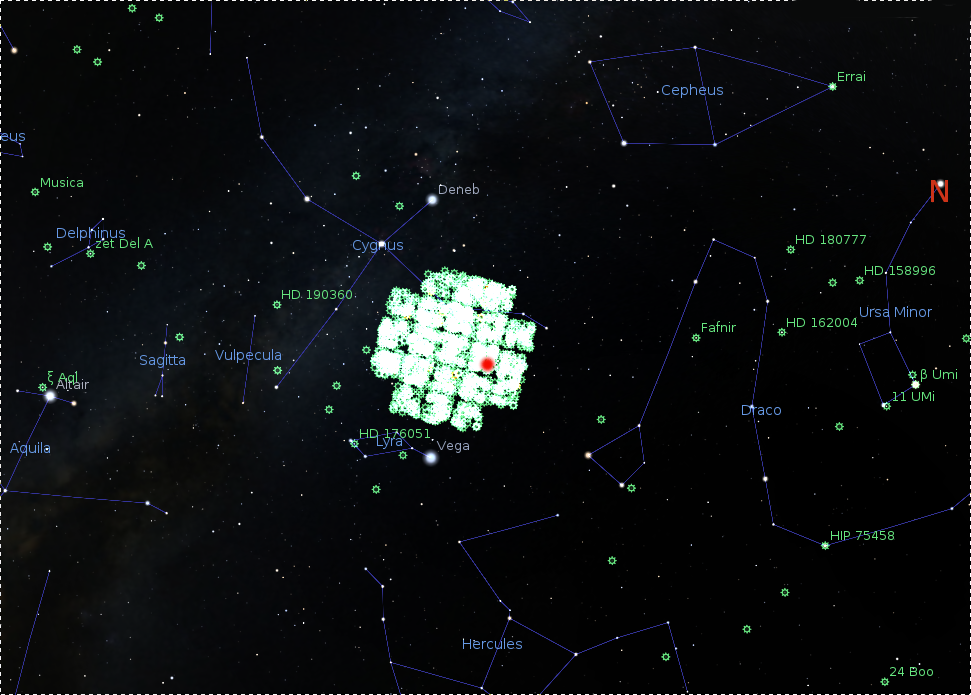Astronomy Object of the Month: 2020, June
< previous Archive next >
Pulsating blue subdwarfs and planets which are not there
In 2011 and 2014,
reports appeared that two pulsating sdBV stars observed by the Kepler Space Telescope, KIC 5807616 and KIC 10001893, could be circled by extrasolar planets on tight orbits. However, a new analysis of the putative planetary signatures found in the light curves of these stars shows that there are no planets around them. The research involved professor Jerzy Krzesiński from the Astronomical Observatory of the Jagiellonian University in Kraków and his PhD student Adam Blokesz from the Pedagogical University of Kraków (JK&AB).
SdBV stars are so-called pulsating B-type subdwarfs, or the stars from extreme horizontal branch of the
Hertzsprung-Russell
diagram (H-R), "burning" helium in their nuclei. In the H-R diagram, the sdB stars are below the main
sequence stars, close to the white dwarf branch. B-type subdwarfs are formed from stars with masses similar to
the mass of the Sun, when they happen to lose most of the hydrogen fuel from their outer shells before the
"helium flash" occurs inside them (meaning the rapid start of the reaction of helium synthesis to carbon and oxygen). Such a scenario of stellar evolution occurs in 1% or 2% of stars in the red giant phase. When this happens, the star does not undergo a further evolutionary step, which is entering the asymptotic branch of the giant H-R diagram, but goes directly from the extreme horizontal branch towards the white dwarf branch.

Illustration: Close-up of the location of the KIC 10001893 star (red circle) and the Kepler Field (the area studied by the Kepler Telescope) on the sky background. Credit: Stellarium.
The authors' arguments may seem convincing, but it is easy to present arguments against, too. Blue subdwarfs are hot stars, with low masses (on the order of half the mass of the Sun), which have passed the red giant stage. Thus, the hypothetical exoplanets orbiting these stars would have to survive the red giant phase of the host star. However, scientists don't think it would be easy. An additional argument against such survivors is the lack of observations indicating the existence of planets orbiting white dwarfs - which are the final stellar evolutionary stage of most of the stars and blue subdwarfs. However, it is not certain if such exoplanets cannot actually exist. Perhaps they are simply very rare.
However, scientists are able to describe the low-frequency signals of their light curves in a qualitative manner by using a number of data reduction techniques and simulating light curves of stars. These methods include techniques for estimating the error of the FT signal amplitude and the FT frequency stability-over-time test. Here, this methods of research made it possible to distinguish between stable signals that may actually come from planets and signals that are definitely not associated with planets.
The goal of the JK&AB team was to accurately determine the characteristics and sources of the weak low-frequency signals observed in the light curves of the discussed subdwarfs. Astronomers analyzed data from the Kepler satellite using the Fourier transform, and then compared their results with Fourier transforms for simulated light curves of the same stars to which they artificially added some typical exoplanetary signals. Simulations have shown that a weak signal with a constant amplitude and frequency (from a hypothetical planet), when added to the stellar light curve, maintains its frequency in the Fourier transform amplitude to an accuracy of 0.03 μHz. Meanwhile, the signals indicated by the authors of earlier papers changed frequencies to a much greater extent.
JK&AB also show that the signal amplitudes found in the low frequency region depend on the methods used for preparing light-curves from Kepler CCD data. For example, it has been shown that the use of a comparison star to reduce data (which may seem strange in the case of data from a space telescope) allows to significantly reduce low frequency noise and exclude artificially generated signals during CCD data reduction by other methods.
Based on these simulation results, JK&AB estimate that two characteristic low-frequency signals in KIC 5807616 light curve are most likely the result of the pulsation modes of the star. For KIC 10001893, the observed signal amplitudes depend on the observational data used and the reduction methods applied. For example, one of the strongest "exoplanetary" signals described in earlier works significantly reduces its amplitude when KIC 10001898 star - the neighbor of the sdBV star KIC 10001893 - is used to reduce the data as the comparison star.
To sum up - the detection of planets around KIC 5807616 and KIC 10001893 could not be confirmed this time.
Original publication: A. Blokesz, J. Krzesinski, L. Kedziora-Chudczer, Analysis of putative exoplanetary signatures found in light curves of two sdBV stars observed by Kepler, Astronomy & Astrophysics, 2019.
The project is part of research conducted at the Department of Stellar and Extragalactic Astronomy of the Jagiellonian University’s Astronomical Observatory. The work was supported by the Polish National Science Centre through the grant 2017/25/B/ST9/00879.
|
Jerzy Krzesiński Astronomical Observatory Jagiellonian University J.Krzesiński [at] oa.uj.edu.pl |


